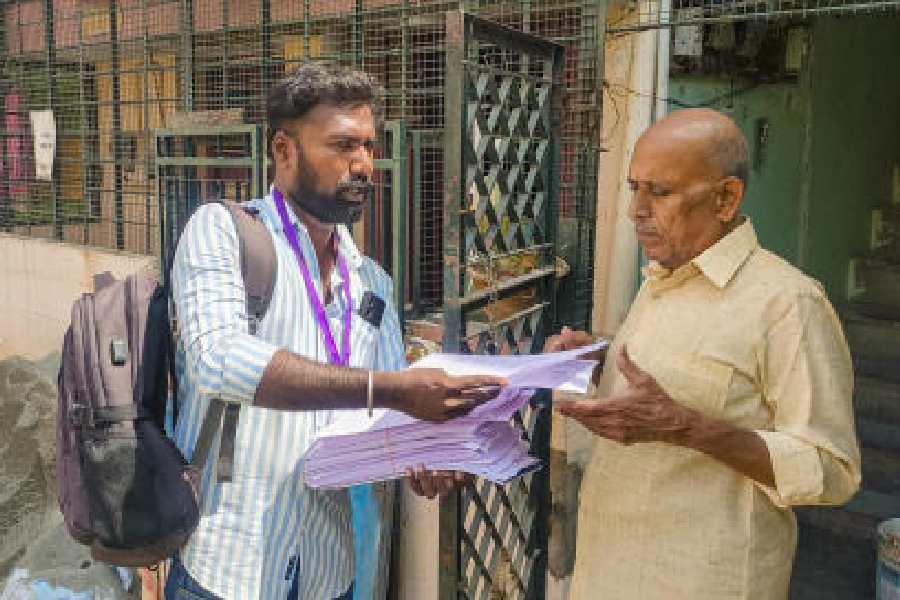 |
The debate about the state of science education and research in India has remained as diffuse and irrelevant as shrubs and undergrowth on barren land. The decline in science and technology is in contrast to the growth in the number of educational institutions, new universities and institutes of higher learning in engineering, science and medicine. The number of engineers, scientists and doctors who graduate annually has grown enormously as well. But the quality of path-breaking scientific research and technological innovation has become abysmally retrograde. The question is whether India should be worried about the appalling quality of most scientific research in the country. The response to this question must be strongly in the affirmative. The erosion of India’s science-led knowledge-base poses a significant threat to its ambitions of economic growth and to its social and security plans.
There are a number of reasons to be not only pessimistic but also extremely concerned about the poor state of cutting-edge scientific research and technological innovation in the country. First, an economically growing nation cannot sustain its growth dynamism and ambitions without a strong underpinning of cutting-edge science and technology. Second, the challenges posed to national security by insignificant investments in indigenous discovery research and new technologies and by depending too much on suppliers from outside are, indeed, enormous. Third, universal health in India will only become affordable with the help of investments in modern medical research in areas such as tropical diseases, pre- and post-natal maternal and infant nutrition and other infectious diseases if India’s emerging demographic profile has to avoid a nightmare scenario. Finally, the uncertainties of global warming and its impact on the availability of food and water will continue to remain unpredictable challenges to our country, in the absence of a commitment to science, of debate on the threats and opportunities created by global warming, and of a robust national mitigation plan.
The advances in science and technology in 20th-century India are owed, to an extent, to a few colonial initiatives, but significantly more to the recognition and prominence given to fundamental scientific research by the new leaders of independent India and to the support and acknowledgement of the pre-eminent role of famous scientists like Homi Bhabha, Meghnad Saha, Shanti Swarup Bhatnagar and a host of luminaries following in the footsteps of C.V. Raman, Jagdish Chandra Bose, S. Ramanujan, et al.
The political and commercial sectors in India are populated primarily by lawyers, economists, landed gentry and inheritors of wealth. In this context, it was the unusual wisdom and foresight of the political leaders of independent India that reinforced the foundation of scientific research in the country as a national priority. The concept of investing in research and development has been historically absent in Indian industry, with notable exceptions. This attitude has its origin in the trading traditions of Indians, who were amply rewarded for meeting the commercial interests of a colonial economy.
The surge of interest in scientific research and new technologies following Independence, however, did not last very long in spite of the growth of pre-eminent institutions such like the Council of Scientific and Industrial Research, the Departments of Atomic Energy, Space and Defence Research. In those early years after Independence, investments in civilian and academic research have a patchy and indifferent history. During the economic and foreign-exchange crisis of the 1950s and 1960s, when imports had to be severely restricted, there were sporadic attempts to bring together scientists and technologists to explore import substitution using local natural products. But such successful initiatives were notable exceptions rather than the rule. World-class R&D institutions like the TIFR, IISc, the Saha and Bose Institutes were already well-established and internationally recognized. These few institutions, fortunately, have maintained their tradition of nurturing world-class research and the training of young scientists. The other important development of the early post-Independence period was the establishment of the Indian Institutes of Technology at Kharagpur, Bombay, Madras, Delhi and Kanpur.
The mode of entry of aspirants to the handful of leading institutions of science education and research is still strictly merit-based. For example, the Joint Entrance Examination for entry into the IITs is one of the toughest filters for ranking and selecting talent. While this example shows that we can pursue excellence when we put our mind to it, sadly, in the early years, the graduate and post-graduate scientists and engineers emerging from these famous institutions had very few domestic opportunities and challenges to convert their knowledge into wealth for the country, in a discouraging environment of sustained low economic growth and an era of what has become known as the “licence permit raj”. As a consequence, India mutely witnessed years of “brain drain” of talented scientists and engineers, primarily to the United States of America and some to Europe, the developed economies that most benefited from the high quality of Indian human resources. The accomplishments of Indian scientists in virtually all disciplines and industries over the decades, outside India, are well documented and widely acknowledged, including a number of winners of the Nobel.
During the post-Independence years of low economic growth, the erosion of the quality of India’s educational institutions and scientific research continued silently. India could no longer boast of an emerging group of renowned leaders, either in academia or civilian scientific research, who could raise their voices in policy debates and be heard above the politicians and economists, and warn about the dangers of neglecting scientific research and building a knowledge-base for India. The fortunate exception was the launch of the first “Green Revolution”, when the Indian agricultural community, led and guided by the government of India and scientists from the Indian Council for Agricultural Research, transformed the face of India’s food production by the rapid and widespread adoption of semi-dwarf wheat-germ plasm from the US and Mexico and semi-dwarf rice strains from Taiwan. Unfortunately, it was also during this period that India encouraged widespread plagiarism of foreign technology and intellectual property, giving it the fancy title of “reverse engineering”. In other words, the widespread copying of ideas from others without attributions became the done thing in India, while original thinking and research atrophied.
The fault-lines in India’s scientific research and technology began to make themselves evident during the 1980s and became more pronounced after liberalization of the economy in the 1990s. However, in the meantime, the world of scientific research and discovery had made spectacular advances and grown so large that it is, sadly, no longer possible to forecast when, or if ever, scientific and technological competencies in India will match the needs of India’s economic growth projections and be counted alongside scientifically and technologically advanced countries.
The Indian IT industry has blossomed in the last twenty years, primarily driven by specialized services demanded from abroad and by remaining, in its formative years, outside the radar screen of the State’s restrictive rules and regulations. The impressive growth of the IT and telecom industries is mistakenly considered to be India’s arrival into the forefront of modern technologies. This is, indeed, delusional because India has hardly any R&D base in these two industries — industries that trace their origins to the discovery of the semi-conductor by Bardeen and Shockley in the first half of the last century in the US and to its defence department’s ARPANET project of the 1950s, as the country continues to lead the world in R&D and commerce.
It is universally acknowledged that scientists and technologists have a “fiduciary” responsibility to continuously add, grow and nurture the knowledge base of a nation, to sustain its economic and social advancement as well as its global competitiveness. It therefore follows that both the State and the private sector have an obligation to support R&D in a sustainable manner. This, to an extent, explains why the US accounts for almost 50 per cent of the money spent on global R&D. This also underscores the claim by President Obama that the economic recovery of the US will be driven by discoveries and innovations pushing the revival of manufacturing and services, apart from increasing employment. It is also the reason why China has consistently invested in world-class R&D as one of the principal means of underpinning the world’s second largest economy.
India is well aware of the dangers of falling behind in sustaining economic growth and social justice, and there has been a spurt in investments in primary, secondary and higher education, in new engineering and medical colleges and universities. The pangs of being left behind in the knowledge domain are obvious and visible in the pulls and pressures on India’s domestic economy that are now quite serious. Knowledge generation as a barrier to economic growth is likely to intensify and remain a major challenge for India in the foreseeable future.
On the positive side, the number of graduates and post-graduates joining research institutes and industry is growing significantly. The number of young scientists being recognized for their achievements, annually, by the Bhatnagar award and several fairly generous government stipends and scholarships is also increasing. But there is a severe shortage of credible leaders in science and technology, who are able to influence national policies in any meaningful manner in order to lead India back into cutting-edge excellence, at least in some selected areas comparable, for example, to even what China has been able to achieve.
The inherently high quality of Indian students is acknowledged by many well-known foreign universities, who are keen to set up centres in India while many well-known and large global corporations have already set up world-class R&D centres in India to take advantage of the annual crop of India’s talented young scientists and technologists. In contrast, the attitude of the majority in the Indian corporate sector remains, at best, sporadic and mostly indifferent regarding investment in R&D as a competitive strategy. This attitude among India’s corporate sector may suggest that the heat of competition is not yet threatening enough to force Indian companies to invest willingly or aggressively in scientific research and innovative technologies, as a prime source of competitiveness and market dominance. The rise of the South Korean electronics giants in the Indian and global marketplace is a classic example of the role of R&D in pursuing and achieving market leadership. They have also exposed the fragility of the early Indian brands, which have gradually retreated
The two of the most misused terms in India are “innovation” and “frugal engineering”. As a country, and as a people, we have an in-built capacity to work with limited resources and hence are innovators and survivors, in a manner of speaking. But innovation for survival is quite a different game compared to game-changing innovations needed for competitive leadership. We have yet to acknowledge the fundamental difference between the two instead of using these terms interchangeably and mindlessly. As for “frugal engineering”, we seem to ignore the well-known adage, “Frugal engineering without a knowledge-base becomes fragile engineering.” We keep talking about frugal engineering as if it was something uniquely Indian without appreciating its limited utility in sustainable economic development and competitiveness.
From time to time, we, in this country, get excited by media reports of our plan to send a space-craft to the moon or some advances in super-computing. These may be very important ambitions, but are not even remotely sufficient. The fact remains that no one in India has been awarded a Nobel prize in science or medicine since Raman, barring the recent exception of Ashok Sen, the physicist who received last year the prestigious international award instituted by a Russian, dubbed as the new Nobel prize. Finally, the citation index of scientific papers published from India has been progressively eroding, signalling the falling standard of scientific research and quality of output from India. This is possibly the most important signal that scientific research in India is in deep trouble.
This article is an expression of anguish at India’s scientific community remaining mute witnesses to the erosion of cutting-edge R&D, and at the growing black-hole in the knowledge-base in India and its debilitating consequences for our future generations. Our politicians and economists may have an instinctive feeling of the enormity of this national weakness, but it is our leaders in science and technology who only can define national priorities and help to raise India from the peril of a nation slipping into an abyss of diminishing knowledge and being gradually engulfed by ignorance.










